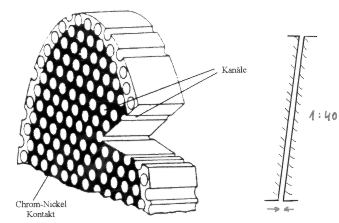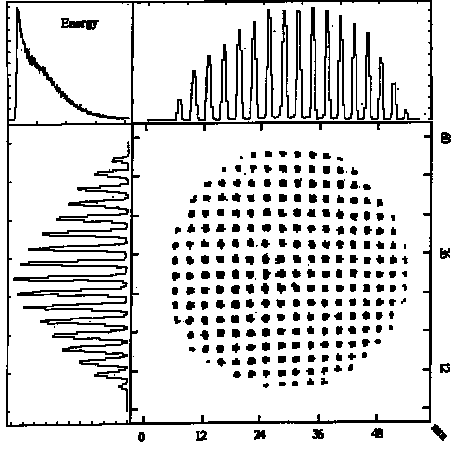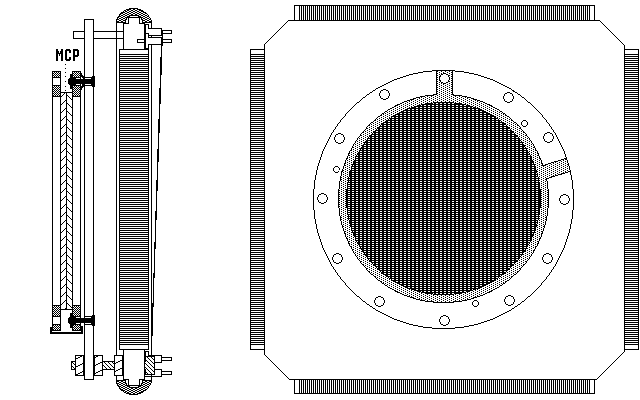|
list of contents:
Microchannel plate (MCP) detectors - What are they and what are they good for?
MCP are made up from a dense stack of millions of individual electron multiplier tubes, each tube having a diameter of typically 10 micrometer and a length of about 1 mm. The ratio L/D (length-to-diameter, here: 100) is between 40 and 120 for standard commercial MCP. The distance between the tubes is only a little bit bigger than the tube diameter.
Macroscopically, MCP are thin discs of a few centimetre diameter (sometimes rectangular shaped) having typically 1 mm thickness. Under a microscope the microstructure reveals and the tiny and densely packed pores that are the entrances to the individual tubes become visible. The "open area ratio", i.e. the ratio of integrated pore area to the total disc area is usually at least 50%.
While the front and back surface of an MCP is coated with metal (input and output electrode), the inside of the tubes is covered with a semi-conducting layer that tends to emit secondary electrons under the bombardment of primary energetic particles, such as photons (UV and higher) or charged particles as electrons. By biasing the MCP electrodes with a high electric field (about 1000V/mm), each of the secondary electrons gains enough kinetic energy to liberate more electrons when it hits the wall. As in every other type of electron multiplier, an avalanche of electrons is forming along the tube that has a charge of a few thousands to a million e (depending on L/D and the electric field), finally exiting the pore.
What makes the MCP unique is the localization of the charge cloud into one tiny pore and the presence of a vast number of pores over a larger area that operate independently.
Thus, an MCP can be used for photon and particle imaging. Furthermore, due to the small size of each individual electron multiplier (each tube) the timing of the photon/particle impact can be determined very accurately (precision of better than 100 psec).
The main purpose of MCP is low-level light amplification. A photo-cathode converts visible photons to electrons, which are projected on the MCP. Behind the MCP a phosphor screen converts the "amplified" charge cloud to photons again, with a high effective light gain.
A single MCP stage shows saturation effects in the pore so that for ultra-low light-level two or more MCP are stacked in series. Thus, individual photons can be made visible, with gains of 10 to 100 million.

one MCP channel

top view of a MCP
The use of MCP in atomic physics experiments:
As mentioned before, MCP have a decent quantum efficiency (QE = number of triggered avalanches/number of incoming particles) also for charged particles. The QE depends on the probability that an incoming particles liberates one (or several) primary electron(s) from the MCP surface and that this electron (at least one) finds its way into a pore for initiating an avalanche. For particles like electrons with a few hundred eV kinetic energy or ions with a few keV or higher this probability is about 50% or higher. Thus, MCP are a perfect tool for detecting charged particles from atomic processes (for lower energetic particles an appropriate front MCP bias can provide the required kinetic energetic).
Very often an MCP is read out with a CCD camera. However, if position and time information is required, this is not an appropriate method. Even if only imaging information is required, a single particle detection method (like the delay line approach) can be superior. (Why not just use CCD for MCP readout?)
How to detect position and time of an individual particle with an MCP stack?
It is rather straightforward to employ the techniques developed for low-level light detection for the imaging of single charged particles emerging from an atomic collision.
However, very often not only the position information is needed but also the arrival time, for example if two are more particles are to be detected in coincidence. Moreover, the exact arrival time of a particle can provide valuable information about a collision process.
The measurement of the timing alone can be done fairly easily by picking up and amplifying the signal that arises when the charge cloud in the MCP forms and exits the stack. But any correlation to a position image obtained "optically", i.e. by the use of a phosphor screen and a camera system turns out to be rather difficult.
The only way to comprise timing information and imaging is to replace the phosphor screen by an "intelligent" anode that codes the particle position in a few electronic signals. Several such methods are described in literature (see SPIE98-conference proceedings[click to download 343kb PDF file) and references therein). We favour the delay-line technique, although we have also experience with the Wedge-and-Strip anode. This method is for example still employed for a special sealed photon detector (SPIE99-conference proceedings (2480kb PDF)).

image of a test mask (1 mm holes in 2.5 mm distance)

delay line anode

delay line anode (Sobottka et al)

readout principle of the wedge & strip anode
Why do we use a delay-line anode for position and time sensitive MCP read-out?
The delay-line method seems to be the only of such techniques that combines the following features:
- high position resolution over large area
- fast read-out (high rate tolerance)
- decent "multi-hit" ability
Especially the multi-hit ability is important for many of our experiments. A "multi-hit" is an event where more than one particle arrive on the MCP in a time period shorter than the read-out time. While the MCP itself responds to such an event with distinct charge clouds for each hit, most electronic read-out schemes cannot handle that. The best method to analyse multi-hit event would be the use of individual parallel read-out channels but very soon the number of channels reaches a practical limit and those "pixel" techniques have a poor position resolution, to mention only one disadvantage.
The delay-line method manages to achieve a high multi-hit ability with only "a handful" of electronic read-out chains but maintains the good position resolution (psd5preprintNIM (1960kb PDF file)).
With our newest development, the Hexanode, we have pushed the performance further to enable even more sophisticated multi-hit experiments. A (limited) number of particles can be detected even when they arrive simultaneously (IEEE-NSS22-82 (665kb PDF file)).
Would you like to get more information on position sensitive MCP detectors? Please download this 1030kb PDF file
or the annual report of related topics (german only, pdf, 456kb)
|
|






